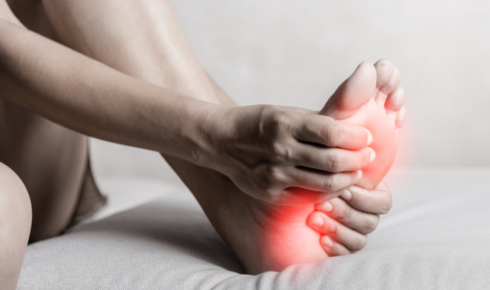Morning steps that feel like walking on pins often start from deeper issues than worn shoes or long shifts. Many people with persistent plantar pain don’t realize how habits, posture, and daily environments quietly stress the heel and arch. Understanding these overlooked triggers helps reveal why pain lingers, even after treatment from a plantar fasciitis specialist or doctor.
Uneven Walking Surfaces Strain the Heel over Time
Uneven ground creates subtle changes in balance that place extra tension on the plantar fascia. Over months of walking across sloped driveways, cracked sidewalks, or uneven flooring, these small imbalances cause the connective tissue under the foot to overstretch and inflame. The strain builds gradually, often without sharp pain at first, but eventually leads to the stabbing heel discomfort people associate with plantar fasciitis.
Many cases seen by a plantar fasciitis doctor trace back to this repetitive imbalance. Unlike exercise-related injuries, surface-related strain affects both the foot and the ankle’s stability, forcing the heel to compensate during each step. Simple adjustments—like using supportive footwear or correcting home flooring irregularities—can significantly reduce recurring irritation.
Poor Mattress Support Affects Foot Alignment During Rest
Sleep posture plays a quiet yet significant role in recovery. A sagging mattress bends the hips and legs in ways that shorten or tighten the plantar fascia overnight. When standing up in the morning, this stiffness makes the first few steps intensely painful. People rarely connect poor sleep support to their foot pain, but it often prolongs healing.
A plantar fasciitis specialist may recommend evaluating bed firmness and pillow placement under the legs. Proper spinal and foot alignment during rest allows the fascia to relax fully, reducing morning inflammation. Quality sleep surfaces support not only the back and neck but also help relieve hidden tension along the feet.
Tight Hip and Back Muscles Transfer Tension to the Arches
Muscular tension in the hips and lower back can alter walking mechanics, sending additional strain to the feet. Restricted hip movement changes stride length and balance, forcing the plantar fascia to absorb extra impact. Over time, this compensatory stress makes even light walking uncomfortable.
A plantar fasciitis doctor often identifies tight hamstrings or hip flexors as contributing factors to recurring pain. Stretching and physical therapy that focus on the upper body can indirectly ease tension across the arches. This connection between posture and fascia health shows how interconnected muscle groups influence heel comfort.
Sudden Weight Fluctuations Increase Pressure on the Fascia
Rapid weight gain or loss can shift how the feet bear pressure. The plantar fascia, designed to cushion and stabilize, reacts to these changes by tightening or overstretching. Increased body weight intensifies the downward pull on the heel, while sudden weight loss may reduce the natural padding that absorbs each step.
A plantar fasciitis specialist will often monitor weight changes alongside pain levels. Maintaining stable body weight gives the fascia time to adapt, protecting it from microtears that lead to chronic inflammation. It’s one of the lesser-discussed reasons symptoms return even after rest or therapy.
Long Driving Hours Tighten the Plantar Region Unnoticed
Extended periods behind the wheel can aggravate the plantar fascia more than most realize. Keeping the foot flexed to press pedals restricts circulation and stiffens the arch. Drivers who spend hours in the same position develop tightness that mirrors early signs of plantar fasciitis.
A plantar fasciitis doctor might suggest simple mobility exercises during travel breaks. Stretching the ankles or rolling the feet over a small ball can prevent the fascia from locking up. This proactive care helps commuters and truck drivers avoid long-term inflammation caused by unnoticed muscle restriction.
Old Sports Injuries Alter Gait Mechanics and Balance
Past injuries to the knee, ankle, or Achilles tendon can subtly change the way a person walks. Even after healing, scar tissue or muscle imbalances may cause uneven weight distribution that stresses one side of the foot. This altered gait pattern often becomes a hidden source of heel pain years later.
A plantar fasciitis specialist typically reviews old injury records to uncover these mechanical shifts. Customized orthotics or strengthening routines can correct foot alignment and rebalance movement. Addressing residual effects from sports injuries often resolves chronic pain more effectively than treating the heel alone.
Standing Posture Habits Place Excess Load on One Foot
Standing with weight unevenly distributed across the legs is another overlooked cause of heel inflammation. Many people unconsciously favor one leg, forcing the fascia on that side to bear more tension. Over time, this imbalance causes one heel to ache persistently, even during minimal activity.
Corrective guidance from a plantar fasciitis doctor can retrain posture habits through ergonomic adjustments and stance awareness. Learning to balance body weight evenly prevents overuse of one fascia band and reduces long-term strain. Posture correction also supports better hip and knee alignment, lessening repetitive heel stress.
Ignored Toe Stiffness Disrupts Natural Stride Rhythm
Healthy toe flexibility helps the foot roll smoothly during each step. When stiffness sets in—whether from arthritis, narrow footwear, or injury—the stride shortens, and the arch compensates for lost motion. This subtle change adds pressure to the fascia, worsening plantar fasciitis symptoms.
A plantar fasciitis specialist often includes toe mobility in recovery programs, since proper motion at the front of the foot relieves stress at the heel. Simple exercises such as towel scrunches or toe lifts restore the natural rhythm of walking. By improving toe flexibility, the entire foot moves more efficiently, easing strain throughout the plantar region.




